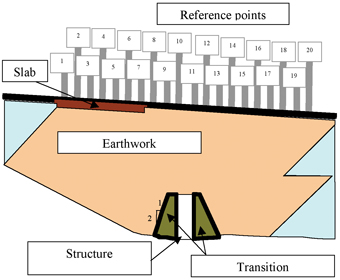Track deterioration in high-speed railways
Posted: 3 April 2007 | | No comments yet
Present requirements of safety and quality in high-speed lines, considering the demand of increased traffic and higher reliability, lead to the introduction of more and more complex analyses in order to guarantee accurate track maintenance. In this context, systematic application of track tests, both dynamic control (measuring vehicle accelerations) and geometric one (measuring levelling, alignment, cant and gauge), is the key-tool in order to plan corrective work on track.
Present requirements of safety and quality in high-speed lines, considering the demand of increased traffic and higher reliability, lead to the introduction of more and more complex analyses in order to guarantee accurate track maintenance. In this context, systematic application of track tests, both dynamic control (measuring vehicle accelerations) and geometric one (measuring levelling, alignment, cant and gauge), is the key-tool in order to plan corrective work on track.
Present requirements of safety and quality in high-speed lines, considering the demand of increased traffic and higher reliability, lead to the introduction of more and more complex analyses in order to guarantee accurate track maintenance. In this context, systematic application of track tests, both dynamic control (measuring vehicle accelerations) and geometric one (measuring levelling, alignment, cant and gauge), is the key-tool in order to plan corrective work on track.
In general, results deduced by track test regarding degradation disagree with formula from theoretical analyses. Reality is different from predicted results: there is a large amount of factors that change predicted track behaviour. Certainly, factors that traditionally have been identified as causes of track degradation (traffic, speed, axle load) are not enough to explain track geometry progression. In this sense, stability of infrastructure has relevant influence on process of track degradation: high earthworks or structures that modify vertical stiffness of track are able to generate punctually intensive degradation. Difficulty to quantify influence of these factors is due to the stochastic characteristics of most of them.
Formulas deduced from analysis of data from Madrid – Seville high-speed line corroborate in general laws used in other lines, explaining variations of track degradation by influence of traffic, speed and axle loads, although there is excessive dispersion. This dispersion is mostly caused by stochastic elements of infrastructure.
Relationship between geometric track deterioration and traffic
With the impossibility to characterize exactly lost of geometric track quality (in terms of levelling and alignment) lead to collect data from lines of different managers in the 70’s. In this context, D-117 ORE Committee, searching , established the following expression, which agreed with data collected from lines in operation:


Being: S, vertical track settlement after traffic T;
a1 and a0, constants related to the first track settlement and to speed of track settlement respectively; and
TR, a reference traffic equal to 2·106 t.
Similarly, –the most representative variable of geometric track quality– could be calculated using the following expression:


being: b1 and b0, constants related to the first track settlement and to speed of track settlement respectively (table 1).
Despite above formulas, experience on the Paris – Lyon high-speed line leads to different relationships between track levelling degradation and traffic, especially for the first years of operation. As it is known, during this period of time, stabilization of infrastructure is progressive, reducing speed of generation of defects. In general, technical references agree that geometric track degradation depends on traffic and also on speed and axle loads. However, values that quantify influence of each factor are very different from one author to another.
Madrid – Seville high-speed line experience
Data from dynamic inspection of track geometry on the Madrid – Seville high-speed line from 1992 to 2003 has been analysed deeply. As it is known, the dynamic inspection consists of measuring accelerations at several parts of a railway laboratory vehicle. Specifically, vertical acceleration of un-sprung masses (aum), lateral acceleration of bogies (ab), vertical acceleration (avv) and horizontal acceleration (ahv) of the body car are measured and compared with certain limits in order to detect faults of levelling or alignment.
Studying faults detected in accelerations measured in axle boxes in Madrid – Seville high-speed line (vertical acceleration of un-sprung masses), a new formula of levelling track degradation has been defined (Ubalde, 2004).
The line (471 km long) was divided into 10 m long sections and 150 sessions (from 1992 to 2003) were considered in the analysis in order to maximize precision. As you can check, values of exponents are consistent with results of other authors (table 2).
It is important to take into consideration that accelerations measured in axle boxes are related to short wave faults; these faults are due to degradation of superstructure (ballast, sleepers and rails). In contrast, accelerations measured in sprung masses are related to long wave faults, which are due to infrastructure.
Consequently, we can say that degradation of track superstructure depends on speed, axle loads and traffic; but there is a part of levelling defaults caused by infrastructure and it is not explained by the above formula. It is necessary to introduce new factors (stochastic parameters) to be taken into consideration.
Earthworks and structures: effects on track degradation
One of the factors that mostly affect quality of track levelling is presence of earthworks. In general, the highest the earthwork is, the most intensive maintenance is required. This effect is most noticeable if you consider ratio between height and length of the earthwork. However, there is no clearly mathematical relationship, due to the incidence of process of construction, quality of materials, conditions of drainage, etc.
Degradation of track levelling at earthworks is more important where there is variation of vertical stiffness, which happens in embankment-bridge transitions. On the Madrid – Seville high-speed line, some transitions have been analysed: ratio of faults detected on them is higher than on the rest of the line (López Pita & Ubalde, 2004), but it is difficult to establish a law to predict necessity of track maintenance for a specific kind of transition: dispersion is too high. Characteristics of each transition (design, materials, process of construction, meteorology, etc.) are different and process of settlement varies from one case to another.
In figure 1, you can see diagram of an earthwork of Madrid – Seville high-speed line. Process of settlement is completely affected by presence of a structure in the middle of the earthwork. If you consider trend of settlement at two sides of the structure, you see that behaviour of earthwork is different from one side to another. Even, from 1992 to 1995 at the left side there was more settlement in comparison with the right, although height of earthwork was larger at the right side, which is contradictory with theory. This fact compelled to construct a concrete slab in 1995. After this, process of settlement was compensated in both sides of the structure.
Certainly, the most effective solution to counter problems of track infrastructure consists of improving structural quality of earthworks and drainage. Compensating these problems only by tamping work on the superstructure could be a short-time solution but not enough to get permanent stability.
Anyway, statistics of maintenance tasks indicate that maximum degradation of track geometry is located in embankment-structure transition. Teixeira (2003) worded how determinant variation of vertical stiffness is in terms of levelling degradation; data from Madrid – Seville high-speed line confirms this observation. In all points where there are more than 0,2 interventions per month on average, there are mostly structures.
Meteorology Influence
Certainly meteorology is not neutral in settlement process of infrastructure. On one hand, you have to take into consideration that tamping work has to be reduced during hot weather in order to avoid deformation of rails. This is an important restriction which generates more degradation of track levelling during summer. On the Madrid – Seville high-speed line, tamping work decreases in August and September, which implies more density of faults. On the other hand, in autumn there are in general higher values of density of faults (in contrast with averaged value) due to rainy weather typical of this season of the year.
Conclusions
Track geometry degradation at ballasted high-speed lines depends on traffic, running speed and axle load of vehicles. These parameters have been identified as key-factors by theoretical studies and experience of lines in operation. However, values of track degradation using laws based on these parameters suppose a high dispersion when they are compared with real data.
In order to explain in detail process of degradation not only do the above parameters have to be considered, but also location of earthworks and structures, or even meteorological conditions have to be studied. Of course, all this implies relevancy when machinery and staff for maintenance is going to be designed.
Experience at Madrid – Seville high-speed line confirms this point: although a new law of degradation has been deduced from statistical data from the dynamic control (law that depends on traffic, speed, and axle load), high standard deviation of data leads to consider the influence of stochastic parameters.


Figure 1
References
- LÓPEZ PITA, A. (1981). “Contributo alla conoscenza del fenomeno di degradazione del binario”. Ingegneria Ferroviaria, 2. 1-16.
- LÓPEZ PITA, A. (1984). “Parámetros fundamentales en el asiento de la vía: su influencia relativa”. Revista A.I.T., 56: 40-57.
- LÓPEZ PITA, A. (1998). HISPEEDMIX: High speed freight on the European high speed railway network. Workpackage 5. Report N. 2. HISPEEDMIX PROJECT (“Transport RTD Programme” in IV Framework Programme). [Universitat Politècnica de Catalunya].
- LÓPEZ PITA, A. (2002). 1er Curso de Actualización en Infraestructura y Superestructura Ferroviaria. Volumen IV. [CENIT (Centro de Innovación del Transporte)].
- LÓPEZ PITA, A.; UBALDE, L. (2004). “Evolution of track deterioration in high-speed railways, depending on the main parameters of traffic and characteristics of infrastructure”. Railway Engineering 2004 Congress. London.
- TEIXEIRA, P. F. (2003). Contribución a la reducción de los costes de mantenimiento de vías de alta velocidad mediante la optimización de su rigidez vertical. Ph-D. Thesis. Technical University of Catalonia (UPC).
- UBALDE, L. (2004). La auscultación y los trabajos de vía en la línea del AVE Madrid – Sevilla: análisis de la experiencia y deducción de nuevos criterios de mantenimiento. Ph-D. Thesis. Technical University of Catalonia (UPC).
Acknowledgement
The authors would like to express their deep gratitude and appreciation to RENFE (Dirección de Infraestructura AVE) for granting us access to inspection data from track of Madrid – Seville high-speed line. Without this information, we would not have been able to elaborate this paper and deduce the above results. The authors are the responsible for all the contents of this paper.
OUT NOW: The Definitive Guide to Rail’s Digital Future
The rail industry is undergoing a digital revolution, and you need to be ready. We have released our latest market report, “Track Insight: Digitalisation.”
This is not just another report; it’s your comprehensive guide to understanding and leveraging the profound technological shifts reshaping our industry. We move beyond the buzzwords to show you the tangible realities of AI, IoT, and advanced data analytics in rail.
Discover how to:
- Optimise operations and maintenance with real-time insights.
- Enhance passenger services through seamless, high-speed connectivity.
- Leverage technologies like LEO satellites to improve safety and efficiency.
Featuring expert analysis from leaders at Nomad Digital, Lucchini RS, Bentley Systems and more, this is a must-read for any rail professional.







